HONDA CR-V 2005 RD4-RD7 / 2.G Owners Manual
Manufacturer: HONDA, Model Year: 2005, Model line: CR-V, Model: HONDA CR-V 2005 RD4-RD7 / 2.GPages: 274, PDF Size: 4.34 MB
Page 221 of 274

Fill the f uel tank.
Change the engine oil and f ilter.
Wash and dry the exterior
completely.
Cleantheinterior.Makesurethe
carpeting, floor mats, etc., are
completely dry.Block the rear wheels.
If the vehicle is to be stored f or a
longer period, it should be
supported on jackstands so the
tires are of f the ground.
Cover the vehicle with a
‘‘breathable’’ cover, one made
f rom a porous material such as
cotton. Non-porous materials, such
as plastic sheeting, trap moisture,
which can damage the paint.
If you need to park your vehicle f or
an extended period (more than 1
month), there are several things you
should do to prepare it f or storage.
Proper preparation helps prevent
deterioration and makes it easier to
get your vehicle back on the road. If
possible, store your vehicle indoors. Leave one window open slightly (if
the vehicle is being stored
indoors).
Disconnect the battery.
Support the f ront and rear wiper
blade arms with a f olded towel or
ragsotheydonottouchthe
windshield.
To minimize sticking, apply a
silicone spray lubricant to all door
and tailgate seals. Also, apply a
vehiclebodywaxtothepainted
surfaces that mate with the door
and tailgate seals.If possible, periodically run the
engine until it reaches f ull
operating temperature (the
cooling f ans cycle on and of f
twice). Pref erably, do this once a
month.
If you store your vehicle f or 1 year or
longer, have your dealer perf orm the
inspections called f or in the 2 years/
30,000 miles (48,000 km)
maintenance schedule (Normal
Conditions) as soon as you take it
out of storage (see page ). The
replacements called f or in the
maintenance schedule are not
needed unless the vehicle has
actually reached that time or mileage.
Leave the parking brake off. Put
the transmission in reverse
(manual) or Park (automatic).
187
Vehicle Storage
218
Page 222 of 274

This section covers the more
common problems that motorists
experience with their vehicles. It
gives you inf ormation about how to
safely evaluate the problem and what
to do to correct it. If the problem has
stranded you on the side of the road,
you may be able to get going again.
If not, you will also f ind instructions
on getting your vehicle towed.....................
Changing a Flat Tire .220
.............
If the Engine Won’t Start . 227
................................
Jump Starting .229
..............
If the Engine Overheats . 231
.........
Low Oil Pressure Indicator . 233
..........
Charging System Indicator . 233
.......
Malf unction Indicator Lamp . 234
...............
Brake System Indicator . 235
..................
Closing the Moonroof . 236
..............................................
Fuses .237
..............................
Fuse Locations .240
......................
Emergency Towing .242
Taking Care of the Unexpected
T aking Care of t he Unexpect ed
219
Page 223 of 274
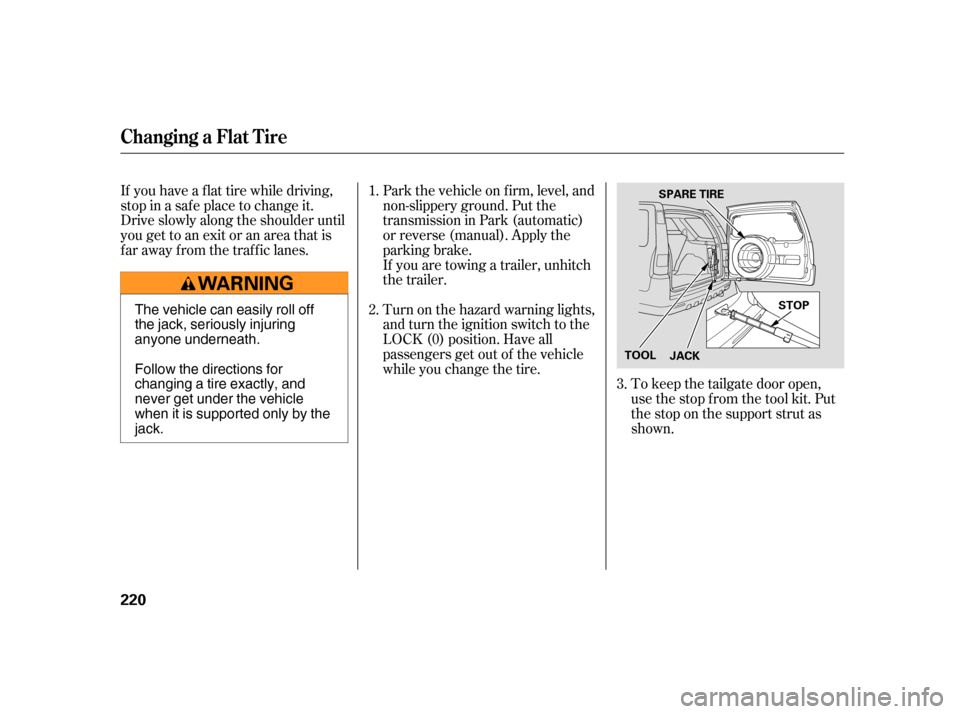
To keep the tailgate door open,
use the stop f rom the tool kit. Put
the stop on the support strut as
shown.
If you are towing a trailer, unhitch
the trailer.
Turn on the hazard warning lights,
and turn the ignition switch to the
LOCK (0) position. Have all
passengers get out of the vehicle
while you change the tire.
If you have a f lat tire while driving,
stop in a saf e place to change it.
Drive slowly along the shoulder until
you get to an exit or an area that is
far away from the traffic lanes.
Park the vehicle on f irm, level, and
non-slippery ground. Put the
transmission in Park (automatic)
or reverse (manual). Apply the
parking brake.
1.
2.
3.
Changing a Flat T ire
220
JACK
STOP
SPARE TIRE
TOOL
The vehicle can easily roll off
the jack, seriously injuring
anyone underneath.
Follow the directions for
changing a tire exactly, and
never get under the vehicle
when it is supported only by the
jack.
Page 224 of 274
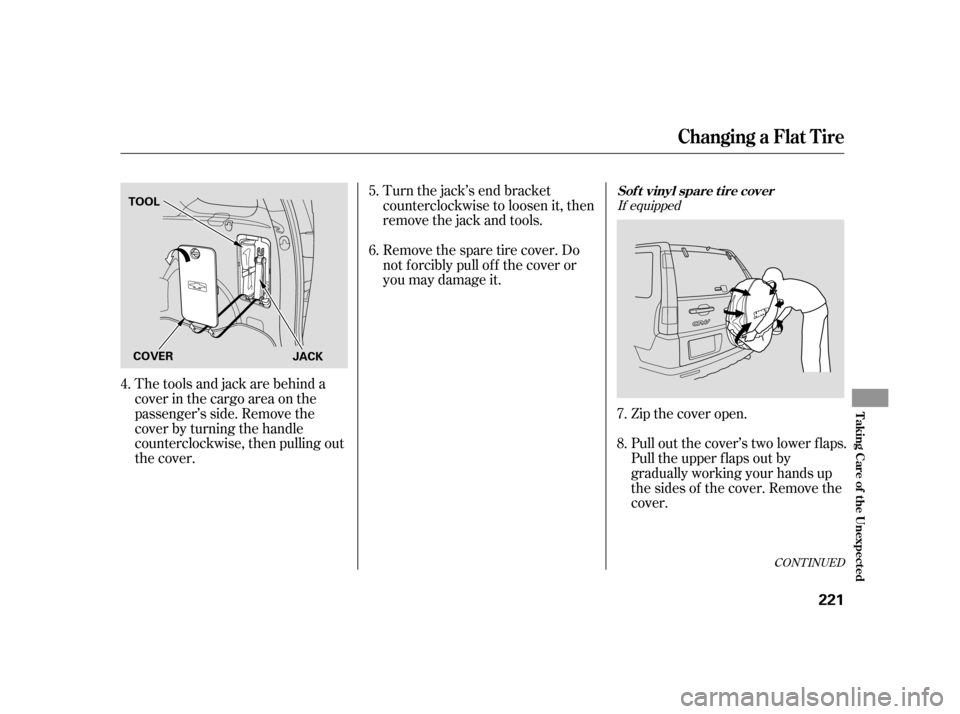
CONT INUED
Thetoolsandjackarebehinda
cover in the cargo area on the
passenger’s side. Remove the
cover by turning the handle
counterclockwise, then pulling out
the cover.
Zip the cover open.
Pull out the cover’s two lower flaps.
Pull the upper f laps out by
gradually working your hands up
the sides of the cover. Remove the
cover.
Turn the jack’s end bracket
counterclockwise to loosen it, then
remove the jack and tools.
Remove the spare tire cover. Do
not f orcibly pull of f the cover or
you may damage it.
6.
5.
4.
7.
8.
If equipped
Changing a Flat T ire
Sof t vinyl spare t ire cover
T aking Care of t he Unexpect ed
221
COVER
TOOL
JACK
Page 225 of 274

Pull of f the center spacer. Using
the wheel wrench, loosen the
three wheel nuts and remove them.
Remove the spare tire from the
holder.
Unzip the flap around the lower
edge of the cover.
Pull out the bottom of the cover,
then gradually pull it of f .
Loosen each wheel nut 1/2 turn
with the wheel nut wrench.
Place the jack under the jacking
point nearest the tire you need to
change. It is pointed to by an
arrow molded into the underside
of the body. Turn the end bracket
clockwise until the top of the jack
contacts the jacking point. Make
sure the center of the jacking
point tab is resting in the jack
notch.
9. 11.
10.
7.
8.
If equipped
Changing a Flat T ire
Hard plastic spare tire cover
222
CENTER SPACER JACKING POINT
NUTS
Page 226 of 274
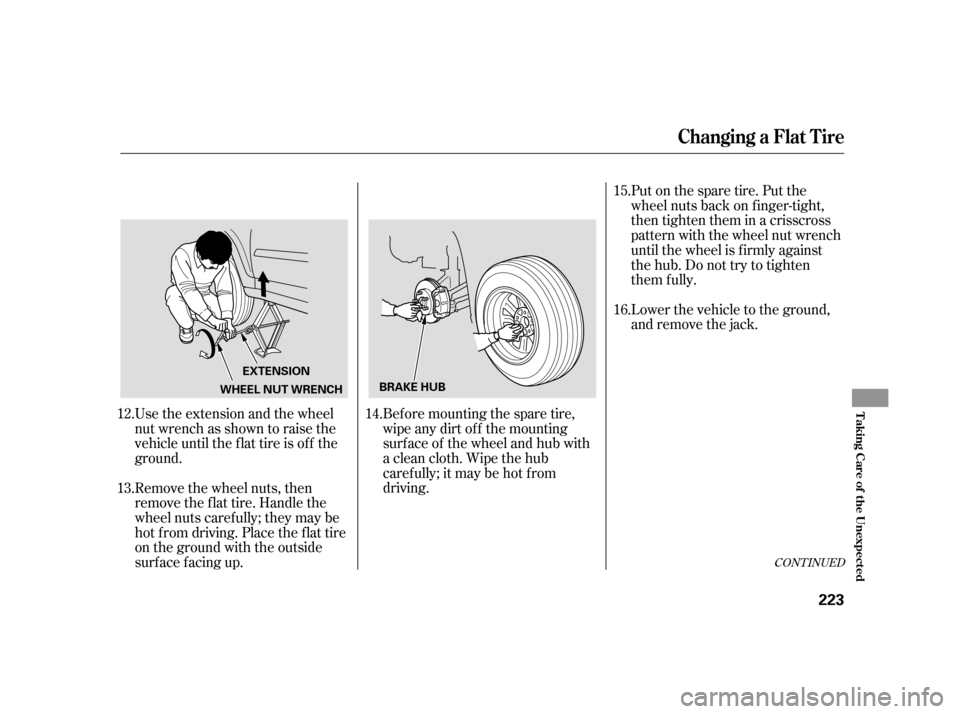
CONT INUED
Bef ore mounting the spare tire,
wipeanydirtoff themounting
surface of the wheel and hub with
a clean cloth. Wipe the hub
carefully;itmaybehotfrom
driving.
Use the extension and the wheel
nut wrench as shown to raise the
vehicle until the f lat tire is of f the
ground.
Put on the spare tire. Put the
wheel nuts back on f inger-tight,
then tighten them in a crisscross
pattern with the wheel nut wrench
until the wheel is f irmly against
the hub. Do not try to tighten
them f ully.
Lower the vehicle to the ground,
and remove the jack.
Remove the wheel nuts, then
remove the f lat tire. Handle the
wheel nuts caref ully; they may be
hot f rom driving. Place the f lat tire
on the ground with the outside
surface facing up.
14. 12.
13.
15.
16.
Changing a Flat T ire
T aking Care of t he Unexpect ed
223
BRAKE HUB WHEEL NUT WRENCH
EXTENSION
Page 227 of 274
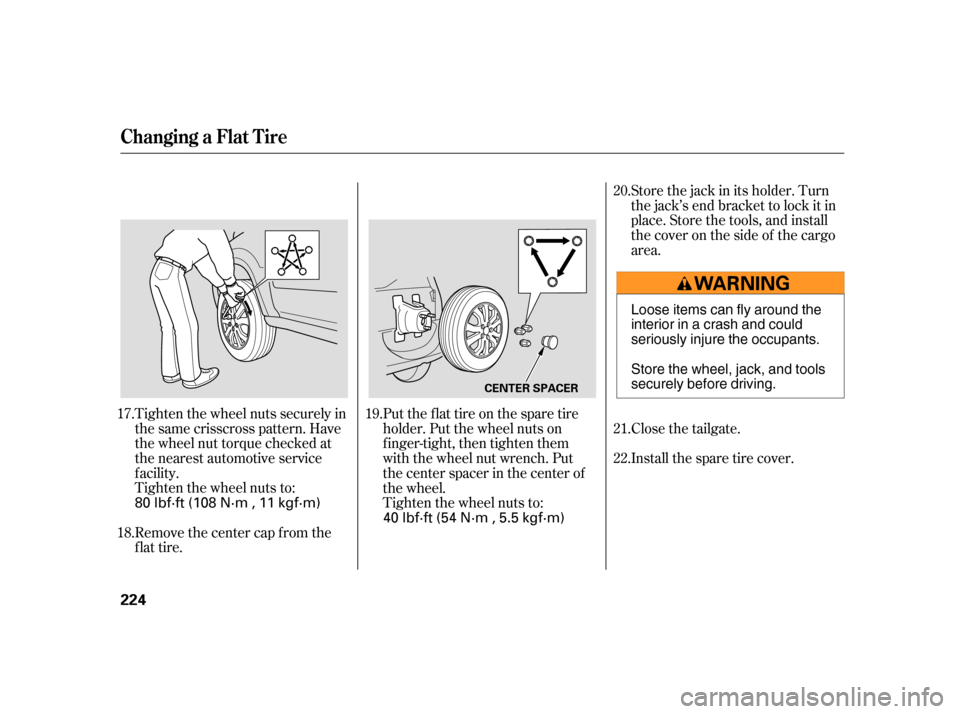
Tighten the wheel nuts securely in
the same crisscross pattern. Have
the wheel nut torque checked at
the nearest automotive service
f acility.
Tighten the wheel nuts to:
Remove the center cap from the
flat tire.
Put the flat tire on the spare tire
holder. Put the wheel nuts on
finger-tight, then tighten them
with the wheel nut wrench. Put
the center spacer in the center of
the wheel.
Tighten the wheel nuts to:
Store the jack in its holder. Turn
the jack’s end bracket to lock it in
place. Store the tools, and install
thecoveronthesideof thecargo
area.
Close the tailgate.
Install the spare tire cover.
17.
18.
19.
20.
22.
21.
Changing a Flat T ire
224
CENTER SPACER
80 lbf·ft (108 N·m , 11 kgf·m)
40 lbf·ft (54 N·m , 5.5 kgf·m)
Loose items can fly around the
interior in a crash and could
seriously injure the occupants.
Store the wheel, jack, and tools
securely before driving.
Page 228 of 274
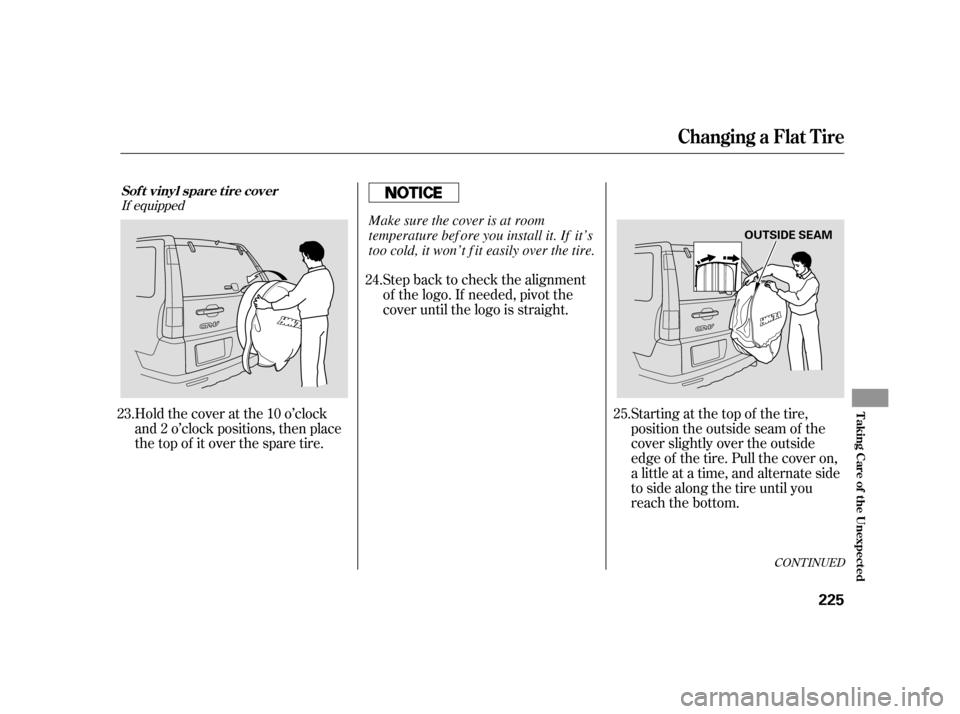
CONT INUED
Step back to check the alignment
of the logo. If needed, pivot the
cover until the logo is straight.
Holdthecoveratthe10o’clock
and 2 o’clock positions, then place
the top of it over the spare tire.
Starting at the top of the tire,
position the outside seam of the
cover slightly over the outside
edge of the tire. Pull the cover on,
a little at a time, and alternate side
to side along the tire until you
reach the bottom.
23.
24.
25.
If equipped
Changing a Flat T ire
Sof t vinyl spare t ire cover
T aking Care of t he Unexpect ed
225
OUTSIDE SEAM
Make sure the cover is at room
temperature bef ore you install it. If it’s
too cold, it won’t f it easily over the tire.
Page 229 of 274
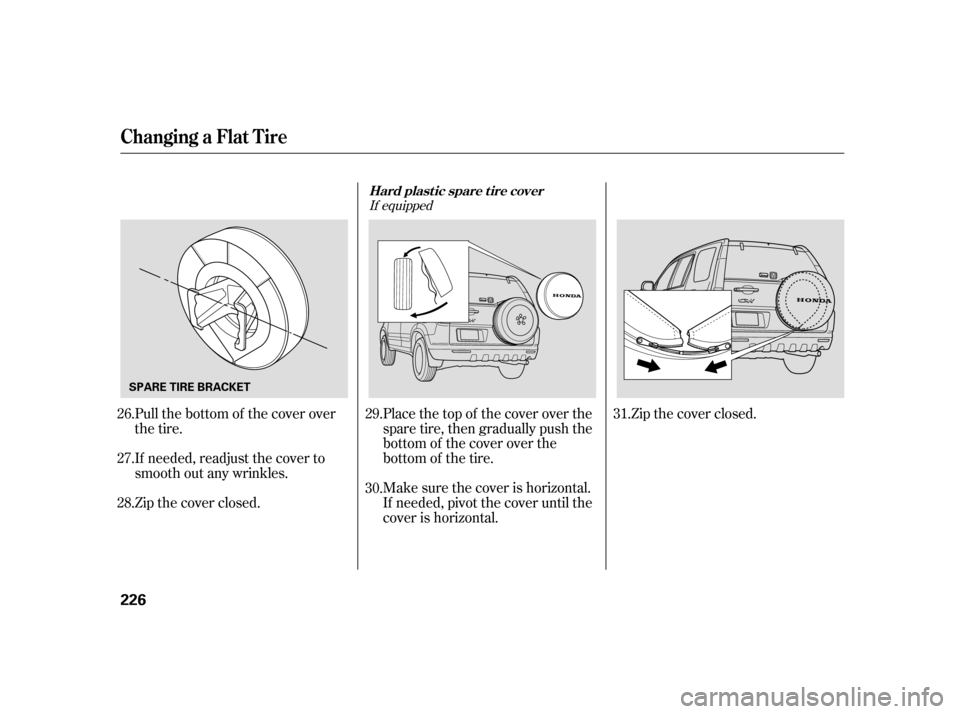
Make sure the cover is horizontal.
If needed, pivot the cover until the
cover is horizontal.
Place the top of the cover over the
spare tire, then gradually push the
bottom of the cover over the
bottom of the tire.
Zip the cover closed. Pull the bottom of the cover over
the tire.
If needed, readjust the cover to
smooth out any wrinkles.
Zip the cover closed.
26.
27.
28.
29.
30.
31.
If equipped
Changing a Flat T ire
Hard plastic spare tire cover
226
SPARE TIRE BRACKET
Page 230 of 274

Diagnosing why the engine won’t
start f alls into two areas, depending
on what you hear when you turn the
ignition switch to the START (III)
position:When you turn the ignition switch to
the START (III) position, you do not
hear the normal noise of the engine
trying to start. You may hear a
clicking sound or series of clicks, or
nothing at all. Turn the ignition switch to the
START (III) position. If the
headlights do not dim, check the
condition of the f uses. If the f uses
areOK,thereisprobably
something wrong with the
electrical circuit f or the ignition
switch or starter motor. You will
need a qualif ied technician to
determine the problem (see
on page ).
If the headlights dim noticeably or
go out when you try to start the
engine, either the battery is dis-
charged or the connections are
corroded. Check the condition of the
battery and terminal connections
(see page ). You can then try
jump starting the vehicle from a
booster battery (see page ).
You can hear the starter motor
operating normally, or the starter
motor sounds like it is spinning
f aster than normal, but the engine
does not start up and run. You hear nothing, or almost
nothing. The engine’s starter
motor does not operate at all, or
operates very slowly.
Turn the ignition switch to the ON
(II) position. Turn on the
headlights, and check their
brightness. If the headlights are
very dim or do not come on at all,
the battery is discharged. Seeon page .
Check the transmission interlock.
If you have a manual transmission,
the clutch pedal must be pushed
all the way to the f loor or the
starter will not operate. With an
automatic transmission, it must be
in Park or neutral.
Check these things:
229217
229242
Nothing Happens or the Starter
Motor Operates Very Slowly
Emergency T owing
Jump Starting
If theEngineWon’tStart
T aking Care of t he Unexpect ed
227